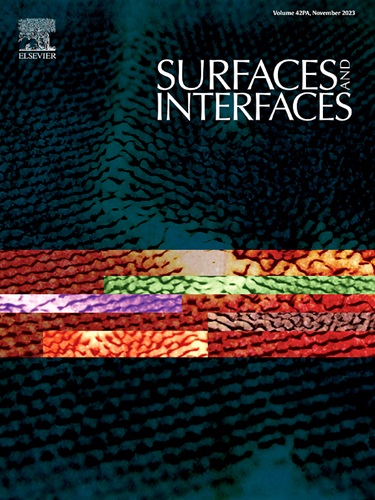六氯二硅烷在氮化硅低温原子层沉积中的吸附机理
IF 6.3
2区 材料科学
Q2 CHEMISTRY, PHYSICAL
引用次数: 0
摘要
氮化硅薄膜(SiNx)被用作介电层、钝化涂层和阻挡层,这对于提高半导体和显示设备的性能、可靠性和耐用性至关重要。随着器件小型化程度的提高,SiNx的原子层沉积(ALD)技术得到了广泛的关注。特别是,在较低温度下,SiNx的热ALD是理想的,以尽量减少衬底的损坏,并确保良好的一致性。六氯二硅烷(Si2Cl6)是为数不多的能够实现SiNx低温热ALD的前驱体之一,但其表面化学反应机理尚未明确。本研究比较了四氯化硅(SiCl4)和Si2Cl6这两种具有代表性的SiNx ALD前驱体的表面反应机理。利用密度泛函理论(DFT)研究了前驱体在SiNx表面的吸附及其与NH3的反应机理。在前驱体吸附和NH3共反应物去除Cl的过程中,发现Si2Cl6具有较高的反应活性,这是由于Si2Cl6中存在Si-Si键。目前的结果表明,在前体分子中直接Si-Si键的存在可能是实现低温ALD过程的关键因素。本文章由计算机程序翻译,如有差异,请以英文原文为准。

Adsorption mechanism of hexachlorodisilane for low-temperature atomic layer deposition of silicon nitride
Thin films of silicon nitride (SiNx) are used as dielectric layers, passivation coatings, and barrier layers, which are crucial for enhancing the performance, reliability, and durability of semiconductors and display devices. Due to increasing miniaturization of devices, atomic layer deposition (ALD) of SiNx is gaining large interest. Especially, thermal ALD of SiNx at lower temperature is desirable to minimize damage of the substrates and to ensure excellent conformality. While hexachlorodisilane (Si2Cl6) is one of few precursors that can enable low-temperature thermal ALD of SiNx, its surface chemical reaction mechanism has not been clarified yet. In this study, the surface reaction mechanisms of silicon tetrachloride (SiCl4) and Si2Cl6, representative precursors for SiNx ALD, are compared. Using density functional theory (DFT) calculations, the mechanisms of precursor adsorption on SiNx surface and subsequent reactions with the counter-reactant NH3 were investigated. Higher reactivity of Si2Cl6 was identified during both the precursor adsorption and removal of Cl by NH3 co-reactant, attributed to the Si-Si bond present in Si2Cl6. Current results suggest that the presence of the direct Si-Si bond within the precursor molecule can be a crucial factor for enabling low-temperature ALD processes.
求助全文
通过发布文献求助,成功后即可免费获取论文全文。
去求助
来源期刊

Surfaces and Interfaces
Chemistry-General Chemistry
CiteScore
8.50
自引率
6.50%
发文量
753
审稿时长
35 days
期刊介绍:
The aim of the journal is to provide a respectful outlet for ''sound science'' papers in all research areas on surfaces and interfaces. We define sound science papers as papers that describe new and well-executed research, but that do not necessarily provide brand new insights or are merely a description of research results.
Surfaces and Interfaces publishes research papers in all fields of surface science which may not always find the right home on first submission to our Elsevier sister journals (Applied Surface, Surface and Coatings Technology, Thin Solid Films)
 求助内容:
求助内容: 应助结果提醒方式:
应助结果提醒方式:


